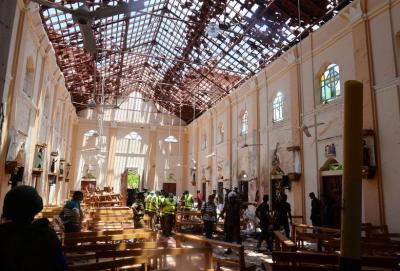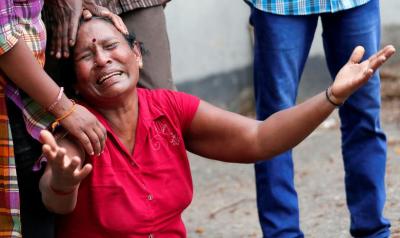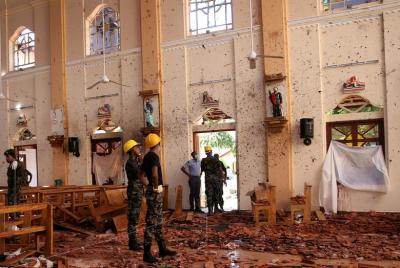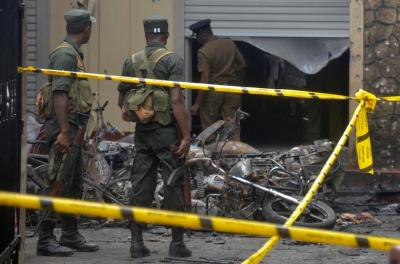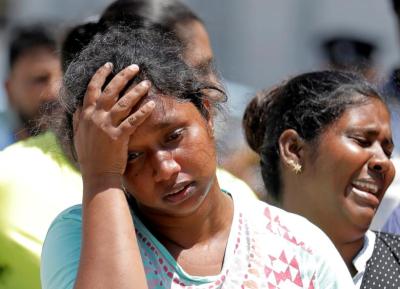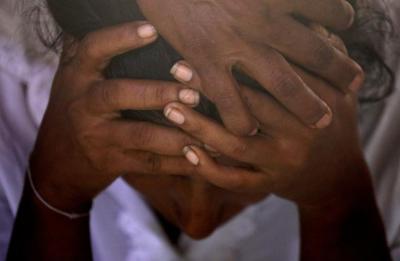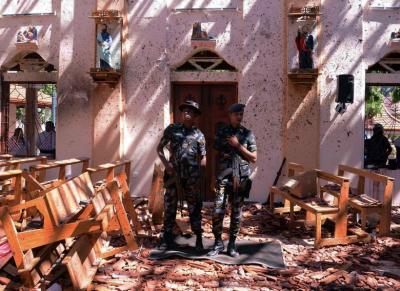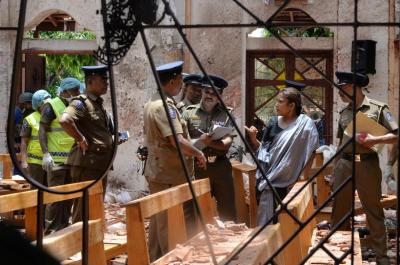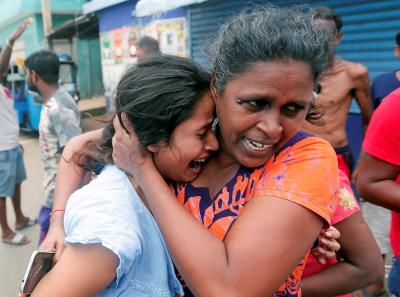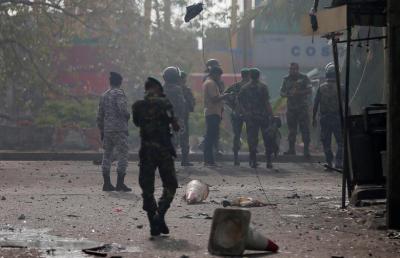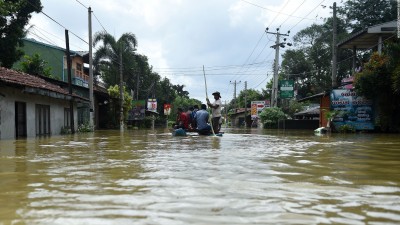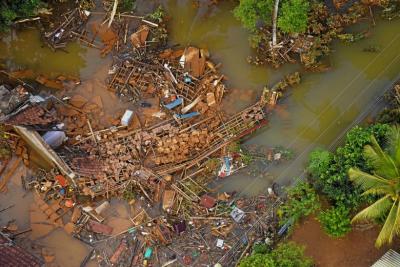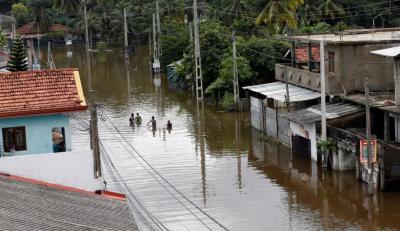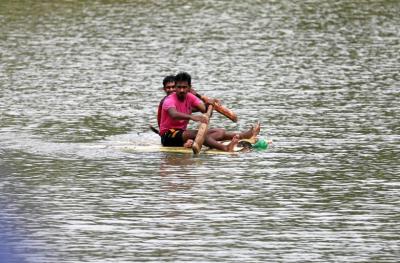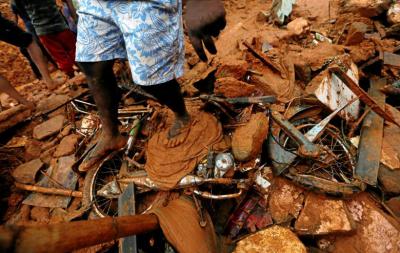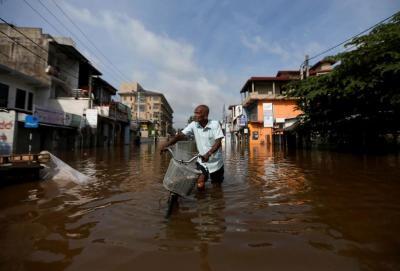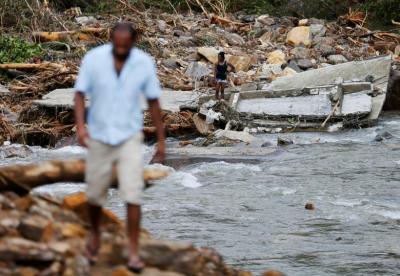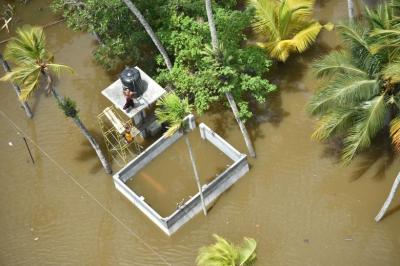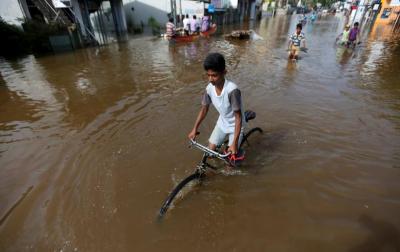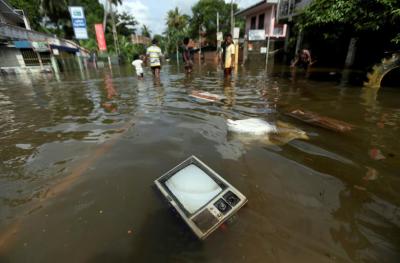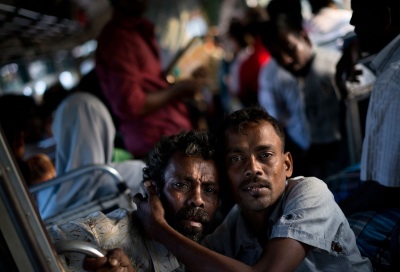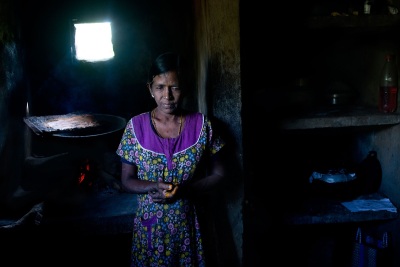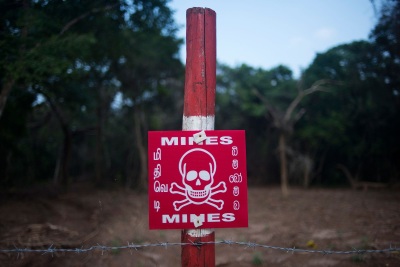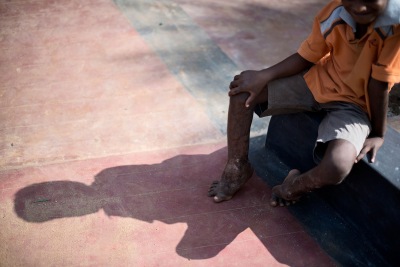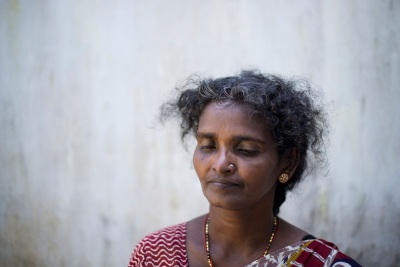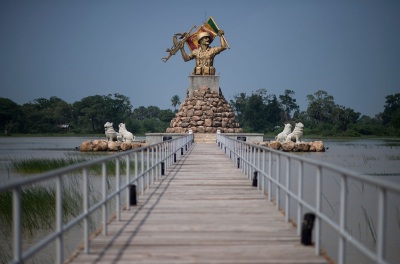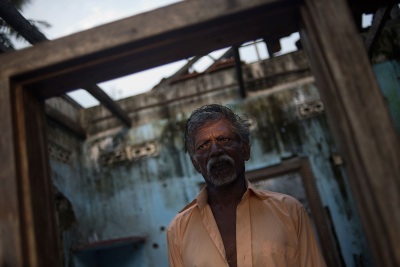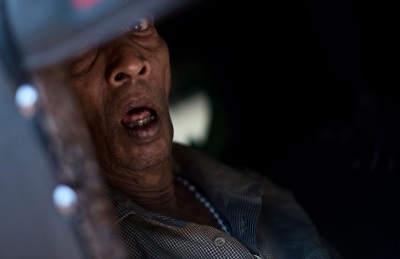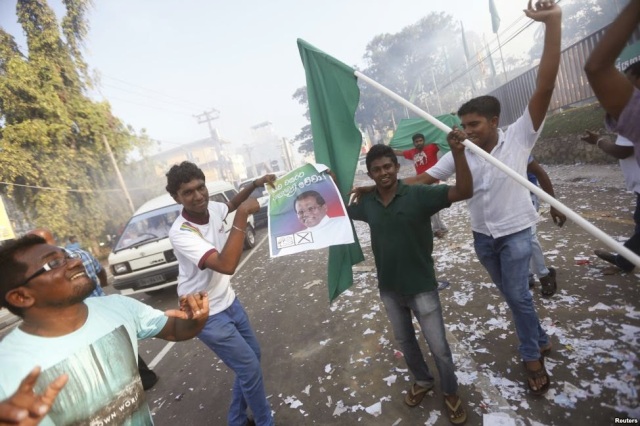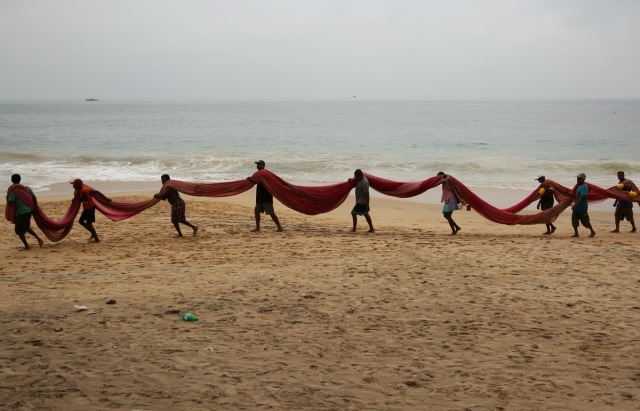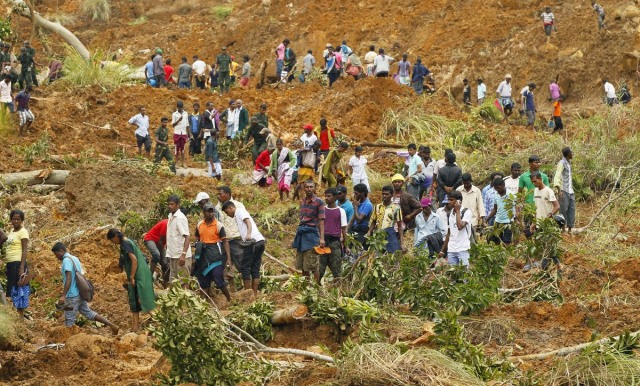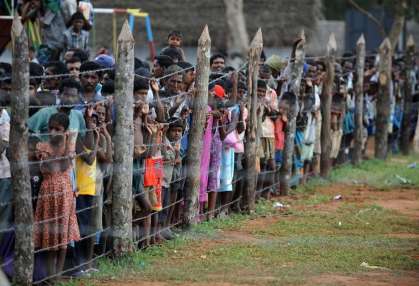
The Sri Lankan Civil War was a conflict fought on the island of Sri Lanka. Beginning on 23 July 1983, there was an intermittent insurgency against the government by the Liberation Tigers of Tamil Eelam (the LTTE, also known as the Tamil Tigers), a separatist militant organisation which fought to create an independent Tamil state called Tamil Eelam in the north and the east of the island. After a 26-year military campaign, the Sri Lankan military defeated the Tamil Tigers in May 2009, bringing the civil war to an end.[1]
For over 25 years, this civil war caused significant hardships for the population, environment and the economy of the country, with an estimated 80,000–100,000 people killed during its course.[16] During the early part of the conflict, the Sri Lankan forces attempted to retake the areas captured by the LTTE. The tactics employed by the Liberation Tigers of Tamil Eelam against the actions of Government forces resulted in their listing as a terrorist organisation in 32 countries, including the United States, India, Canada and the member nations of the European Union.[17] The Sri Lankan government forces have also been accused of human rights abuses, systematic impunity for serious human rights violations, lack of respect for habeas corpus in arbitrary detentions and forced disappearances.[18]
After two decades of fighting and four failed tries at peace talks, including the unsuccessful deployment of the Indian Army, the Indian Peace Keeping Force from 1987 to 1990, a lasting negotiated settlement to the conflict appeared possible when a cease-fire was declared in December 2001, and a ceasefire agreement signed with international mediation in 2002.[19] However, limited hostilities renewed in late 2005 and the conflict began to escalate until the government launched a number of major military offensives against the LTTE beginning in July 2006, driving the LTTE out of the entire Eastern province of the island. The LTTE then declared they would “resume their freedom struggle to achieve statehood”.[20][21]
In 2007, the government shifted its offensive to the north of the country, and formally announced its withdrawal from the ceasefire agreement on 2 January 2008, alleging that the LTTE violated the agreement over 10,000 times.[22] Since then, aided by the destruction of a number of large arms smuggling vessels that belonged to the LTTE,[23] and an international crackdown on the funding for the Tamil Tigers, the government took control of the entire area previously controlled by the Tamil Tigers, including their de facto capital Kilinochchi, main military base Mullaitivu and the entire A9 highway,[24] leading the LTTE to finally admit defeat on 17 May 2009.[25] Following the end of the war, the Sri Lankan government claimed Sri Lanka as the first country in the modern world to eradicate terrorism on its own soil.[26] Following the LTTE’s defeat, pro-LTTE Tamil National Alliance dropped its demand for a separate state, in favour of a federal solution.[27][28] In May 2010, Mahinda Rajapaksa, the president of Sri Lanka, appointed the Lessons Learnt and Reconciliation Commission (LLRC) to assess the conflict between the time of the ceasefire agreement in 2002 and the defeat of the LTTE in 2009.[29]
Origin and evolution
The roots of the modern conflict lie in the British colonial rule when the country was known as Ceylon. There was initially little tension amongst Sri Lanka’s two largest ethnic groups, the Sinhalese and the Tamils, when Ponnambalam Arunachalam, a Tamil, was appointed representative of the Sinhalese as well the Tamils in the national legislative council. In 1919, major Sinhalese and Tamil political organisations united to form the Ceylon National Congress, under the leadership of Arunachalam, to press the colonial masters for more constitutional reforms. However, the British Governor William Manning actively encouraged the concept of “communal representation” and created the Colombo town seat in 1920, which dangled between the Tamils and the Sinhalese.[30]
After their election to the State Council in 1936, the Lanka Sama Samaja Party (LSSP) members N.M. Perera and Philip Gunawardena demanded the replacement of English as the official language by Sinhala and Tamil. In November 1936, a motion that ‘in the Municipal and Police Courts of the Island the proceedings should be in the vernacular’ and that ‘entries in police stations should be recorded in the language in which they are originally stated’ were passed by the State Council and referred to the Legal Secretary. However, in 1944, J.R. Jayawardene moved in the State Council that Sinhala should replace English as the official language. In 1956 Prime Minister S. W. R. D. Bandaranaike’s passage of the “Sinhala Only Act” led to ethnic riots. The civil war is a direct result of the escalation of the confrontational politics that followed.[31]
In late 1960s, documents relating to a separate Tamil state of ’Tamil Eelam’ began to circulate. At this time, Anton Balasingham, an employee of the British High Commission in Colombo, began to participate in separatist activities. He later migrated to Britain, where he would become the chief theoretician of the LTTE. In the late 1960s, several Tamil youth, among them Velupillai Prabhakaran also became involved in these activities. They carried out several hit-and-run operations against pro-government Tamil politicians, Sri Lanka Police and civil administration. Prabhakaran, together with Chetti Thanabalasingam, a well known criminal from Kalviyankadu, Jaffna formed the Tamil New Tigers (TNT) in 1972.[32] This was formed around an ideology which looked back to the 1st Millennium Chola Empire – the Tiger was the emblem of that empire.
A further movement, the Eelam Revolutionary Organisation of Students (EROS), formed in Manchester and London; it became the backbone of the Eelamist movement in the diaspora, arranging passports and employment for immigrants and levying a heavy tax on them. It became the basis of the Eelamist logistical organisation, later taken over entirely by the LTTE. The formation of the Tamil United Liberation Front (TULF) with the Vaddukkodei (Vattukottai) resolution of 1976 led to a hardening of attitudes. The resolution called up for the creation of a secular, socialist state of Tamil Eelam, based on the right of self-determination.[33]
The TULF clandestinely supported the armed actions of the young militants who were dubbed “our boys”. TULF leader Appapillai Amirthalingam, even provided letters of reference to the LTTE and to other Tamil insurgent groups to raise funds.[32] Amirthalingam introduced Prabhakaran to N.S. Krishnan, who later became the first international representative of LTTE. It was Krishnan, who introduced Prabhakaran to Anton Balasingham, who later became the chief political strategist and chief negotiator of LTTE. The “boys” were the product of the post-war population explosion. Many partially educated, unemployed Tamil youth fell for revolutionary solutions to their problems. The leftist parties had remained “non-communal” for a long time, but the Federal Party (as well as its off-shoot, the TULF), deeply conservative and dominated by Vellalar casteism, did not attempt to form a national alliance with the leftists in their fight for language rights.
Following the sweeping electoral victory of the United National Party (UNP) in July 1977, the TULF became the leading opposition party, with around one sixth of the total electoral vote winning on a party platform of secession from Sri Lanka. After the 1977 riots, the J. R. Jayewardene government made one concession to the Tamil population; it lifted the policy of standardisation for university admission that had driven many Tamil youths into militancy. The concession was regarded by the militants as too little and too late, and violent attacks continued. By this time, TULF started losing its grip over the militant groups. LTTE ordered civilians to boycott the local government elections of 1983 in which even TULF contested. Voter turnout became as low as 10%. Thereafter, Tamil political parties had very little room to represent people’s interests as insurgents rose above their position.[32]
Abrogation of ceasefire agreement
Defense secretary Gotabhaya Rajapaksa urged the government to abandon the ceasefire agreement in December 2007,[154] and on January 2, 2008, the Sri Lankan government officially did so. Between February 2002 to May 2007, Sri Lanka Monitoring Mission had documented 3,830 ceasefire violations by the LTTE, with respect to 351 by the security forces.[4] From May 2007, the SLMM ceased making determinations on ceasefire violations. Thus the government stated there was no need for a ceasefire any more. Several donor countries expressed their disappointment at the Sri Lankan government’s withdrawal.[156][157] The LTTE formally responded that since the government had unilaterally withdrawn from the ceasefire agreement without any justification and that they were prepared to continue to honour the agreement, the international community ought to immediately remove the bans it had placed on the LTTE.[158][159]
The government then attempted to open a third front along the Muhamalai Forward Defence Line. After an initial setback on 23 April,[160] the Sri Lankan Army advanced rapidly, capturing the town of Adampan on 9 May,[161] Mannar “Rice Bowl” which consists of the island’s most fertile paddy fields on 30 June,[162]Vidattaltivu on 16 July,[163] and Iluppaikkadavai on 20 July.[164]
On July 21, 2008, the LTTE announced that it would be declaring a unilateral ceasefire from July 28 to August 4, to coincide with the 15th summit of the heads of state of SAARC to be held in Colombo.[165] However, the government of Sri Lanka dismissed the LTTE’s offer as needless and treacherous.[166]
Significant military gains by the government
On 2 August 2008, Vellankulam town, the LTTE’s last stronghold in Mannar District, fell to the advancing SLA troops, completing the eight-month effort to recapture the district.[167] The Army followed this up by taking control of Mallavi on 2 September, following weeks of heavy military confrontation.[168] The LTTE countered with a surprise attack on the Vavuniya air base on 9 September, in which both sides claimed victory.[169][170][171]
From Mannar, the Army had entered Kilinochchi District, the last stronghold of the LTTE, at the end of July,[172] with the intention of taking Kilinochchi before the end of the year. On 3 October 2008, a UN aid convoy managed to unload all its cargo in Kilinochchi District and described Kilinochchi town as having been nearly abandoned,[173] but the LTTE were able to kill retired Major General Janaka Perera along with 26 other victims in a suicide blast on 6 October.[174]
On 17 October 2008, SLA troops cut off the Mannar-Poonaryn A32 highway north of Nachchikuda, the main remaining Sea Tiger stronghold on the northwestern coast of the island, thus effectively encircling it.[175] They began their assault on 28 October and captured it the next day.[176][177] After that the Army Task Force 1 continued their advance towards Pooneryn and captured Kiranchchi, Palavi, Veravil, Valaipadu and Devil’s Point.[178][179] On 15 November 2008, troops of the Army Task Force 1 entered the strategically important Tiger stronghold of Pooneryn.[180][181] Simultaneously, the newly created Army Task Force 3 was introduced into the area of Mankulam with the objective of engaging the LTTE cadres in a new battlefront towards the east of the Jaffna–Kandy A9 highway.[182] SLA troops captured Mankulam and the surrounding area on 17 November 2008.
Meanwhile, the situation of more than 200,000 civilians who had been displaced in the latest round of fighting was turning into a humanitarian disaster; however, due to a number of reasons including doubts regarding the sincerity of the LTTE’s negotiations, neither Western governments nor India intervened to broker a new ceasefire.
Fall of Kilinochchi and subsequent events
Main article: Battle of Kilinochchi (2008–2009)
The Sri Lankan Army began the attack on Kilinochchi on 23 November 2008. Troops were attacking rebels’ defences from three directions.[185] However, the LTTE offered a stiff resistance, and the prolonged attack resulted in heavy casualties on both sides.[186]
Not until 1 January 2009, were SLA troops able to capture Paranthan, located to the north of Kilinochchi along the A-9 route. This isolated the southern periphery of the Elephant Pass LTTE foothold and also exposed the LTTE’s main fortification at Kilinochchi.[187] This made the capture of Kilinochchi, which the rebels had used for over a decade as their de facto administrative capital, far simpler, and they were able to accomplish this on 2 January. The loss of Killinochchi caused a substantial dent in the LTTE’s image as a capable, ruthless terrorist group,[188] and observers forecasted the LTTE was likely to collapse before long under unbearable military pressure on multiple fronts.[189]
The Tigers quickly abandoned their positions on the Jaffna peninsula to make a last stand in the jungles of Mullaitivu, their last main base.[190] The entire Jaffna peninsula was captured by the Sri Lanka Army by 14 January 2009.[191] However, they were unable to hold out for long, and on 25 January, SLA troops captured Mullaitivu.[192][193] The last Sea Tiger base in Chalai was next to fall on 5 February, reducing the territory under rebel control to less than some 200 km2.
This stage of the war was marked by increased brutality against civilians and rapidly mounting civilian casualties. On 19 February 2009, Human Rights Watch issued a report accusing the Sri Lankan army of “slaughtering” the civilians during indiscriminate artillery attacks (including repeated shelling of hospitals) and calling on the Sri Lankan government to end its policy of “detaining displaced persons” in military-controlled internment camps. Human Rights Watch also urged the Tamil Tigers to permit trapped civilians to leave the war zone and to “stop shooting at those who try to flee”.[195] The UN was also concerned over the condition of internally displaced persons and estimated that some 200,000 people were being squeezed into a narrow 14 square kilometre patch of land on the coast in Vanni, which the government had declared the ‘no-fire zone’.[196]
On 20 February 2009, two LTTE planes on a suicide mission carried out a kamikaze style air attack on the Sri Lankan capital Colombo, killing 2 and wounding 45, but both planes were shot down by the Sri Lankan Air Force before they could damage the intended targets which were the Army Headquarters and the main Air Force base.[197][198] By late March, the Tamil Tigers controlled only one square kilometre outside the no-fire zone, down from about 15,000 km2 a mere three years ago. Political pressure was placed on President Rajapaksa to find a political solution to the conflict and he called for a meeting with Tamil National Alliance, but they refused until the government resolved the humanitarian crisis faced by civilians trapped in the fighting.
The Battle of Aanandapuram, which was described by military analyst/journalist D. B. S. Jeyaraj as the “defining moment” of the 3 decade war, was fought on 5 April. This battle saw the demise of most of the battle-hardened ground commanders of the LTTE, including Velayuthapillai Baheerathakumar alias Theepan, the overall commander of the LTTE northern front fighting formations. SLA soldiers numbering more than 50,000 from 5 divisions participated in the battle encircling the LTTE cadres inside a small littoral strip of territory located between the Paranthan-Mullaitivu A35 highway, Nanthikadal and Chalai Lagoons on one side and the Indian ocean on the other. Rebel casualties amounted to 625.[199]
Fighting in the ‘No-Fire Zone’
SLA troops were able to push the Tamil Tigers into the no-fire zone set up for civilians.[200][201] The LTTE then built a 3-kilometre (2 mi) long bund in the no-fire zone, trapping over 30,000 civilians, but the SLA was able to destroy this.[202][203]
On 21 April, Sri Lankan troops launched an assault, targeting LTTE leader, Vellupillai Prabhakaran. At the same time, a mass Tamil exodus from the ‘no-fire zone’ was underway.[204][205] The next day, two senior LTTE members (LTTE media co-ordinator Velayuthan Thayanithi, alias Daya Master, and a top interpreter Kumar Pancharathnam, alias George)[206] surrendered to the advancing Sri Lankan army. This came as “a rude shock” and a major setback for the rebel leadership.[207] When asked why they had surrendered, both men stressed that rebels were shooting at the civilians and preventing them from escaping from the ‘no-fire zone’ to safety in government-controlled areas. They also alleged that the LTTE were still abducting and conscripting children as young as 14 years old, and would fire at anyone who tried to resist.[208][209]
By 25 April, the area under the LTTE was reduced to 10 km2. While the Tamil exodus from the ‘no-fire zone’ continued, the UN estimated that around 6,500 civilians may have been killed and another 14,000 wounded between January 2009 and April 2009.[210][211] The BBC reported that the land recaptured by the army from the rebels was totally depopulated and utterly devastated.[212]
As fighting continued, a group of independent United Nations experts called on the Human Rights Council to urgently set up an international inquiry to address the “critical” situation in Sri Lanka amid fighting between the Army and Tamil rebels. According to the UN Office for the Coordination of Humanitarian Affairs (OCHA), over 196,000 people fled the conflict zone, a shrinking pocket of land on the north-east coastline, where clashes continued between government troops and the LTTE, while at least 50,000 people were still trapped there.[213] A UN spokesman in Colombo, Gordon Weiss, said more than 100 children died during the “large-scale killing of civilians” and described the situation in northern Sri Lanka as a “bloodbath”.[214] UN Secretary-General Ban Ki-moon said he was appalled at the killing of hundreds of Sri Lankan civilians caught in the middle of hostilities between the army and separatist Tamil rebels over the weekend. He voiced deep concern over the continued use of heavy weapons in the conflict zone, but also stressed that the “reckless disrespect shown by the LTTE for the safety of civilians has led to thousands of people remaining trapped in the area”.[215]
On 16 May 2009, Sri Lankan troops broke through LTTE defences and captured the last section of coastline held by Tamil Tiger rebels. The army reported it was set to “clear” remaining rebel-held land within days.[216][217] Later the military claimed, allegedly citing intercepted LTTE communication, that rebels were preparing for a mass suicide after being effectively cut-off of escape routes.[218] Some rebels have been reported to be blowing themselves up.[219]
End of the war
16 May: Sri Lanka declares victory
Addressing the G11 summit in Jordan, President Mahinda Rajapaksa stated “my government, with the total commitment of our armed forces, has in an unprecedented humanitarian operation finally defeated the LTTE militarily”.[14] Sri Lankan Commander of the Army Sarath Fonseka also declared victory over LTTE.[220] Sri Lankan troops raced to clear the last LTTE pockets of resistance. As the last LTTE strongpoints crumbled, Sri Lankan troops killed 70 rebels attempting to escape by boat.[221] The whereabouts of LTTE leader Vellupillai Prabhakaran and other major rebel leaders were not certain.

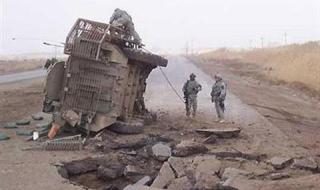 An improvised explosive device (IED) is a homemade bomb constructed and deployed in ways other than in conventional military action. It may be constructed of conventional military explosives, such as an artillery round, attached to a detonating mechanism. Roadside bombs are a common use of IEDs.
An improvised explosive device (IED) is a homemade bomb constructed and deployed in ways other than in conventional military action. It may be constructed of conventional military explosives, such as an artillery round, attached to a detonating mechanism. Roadside bombs are a common use of IEDs.


